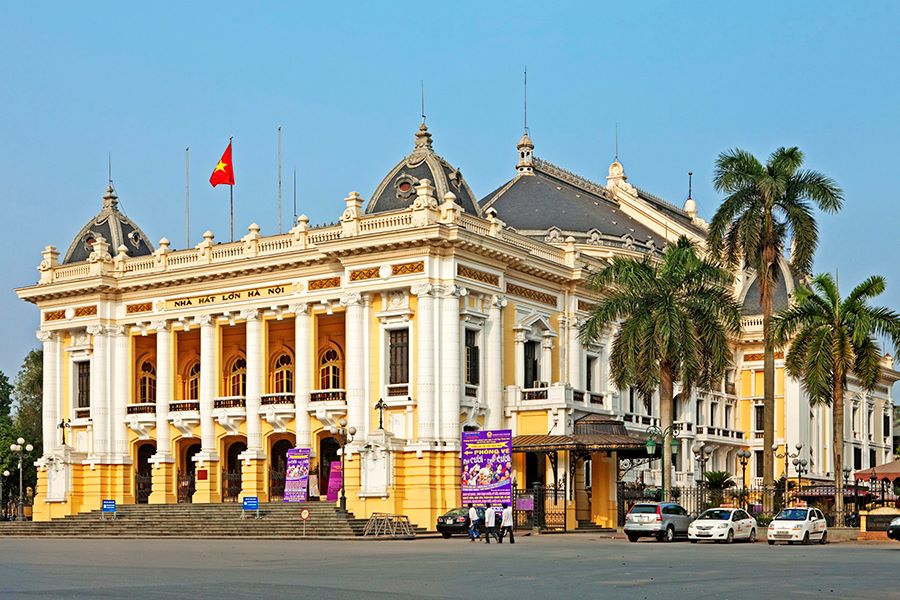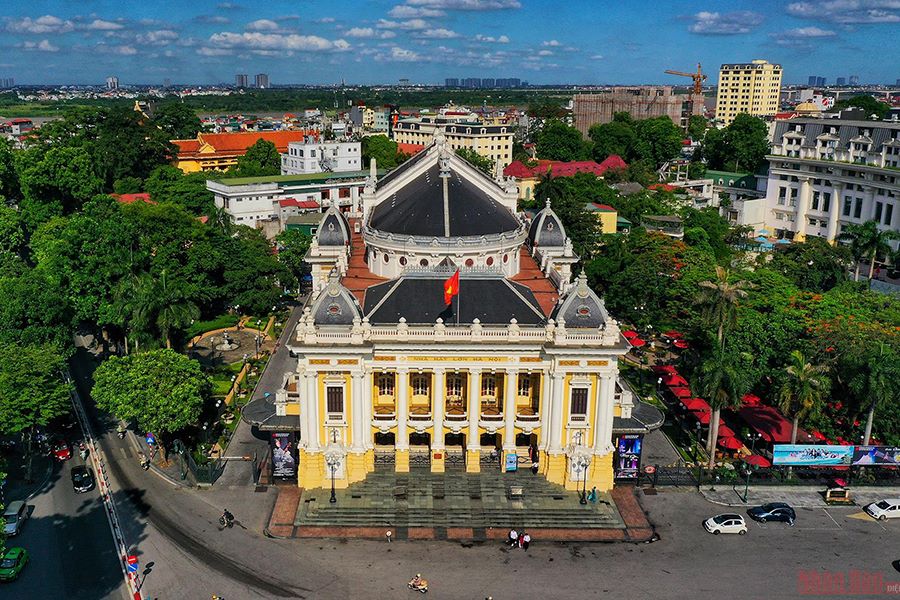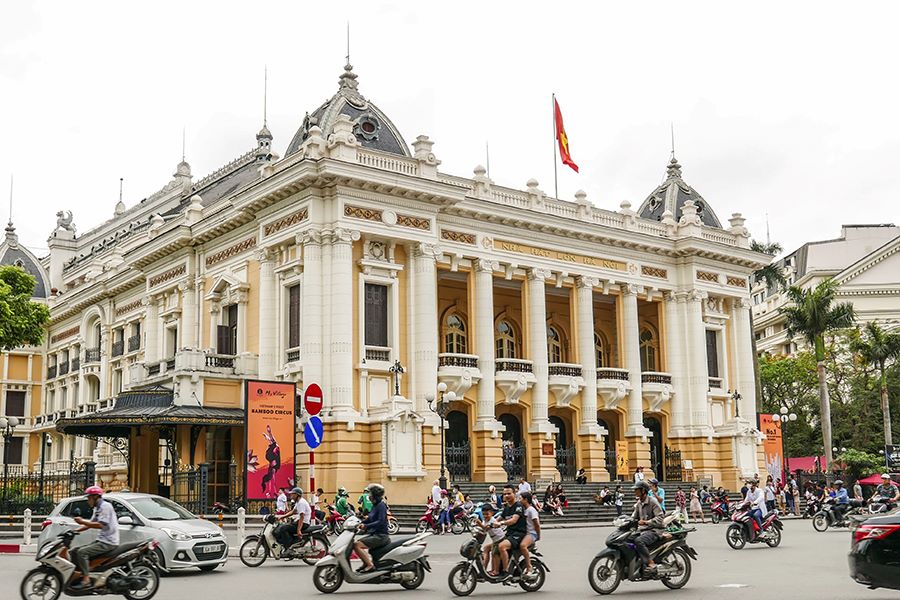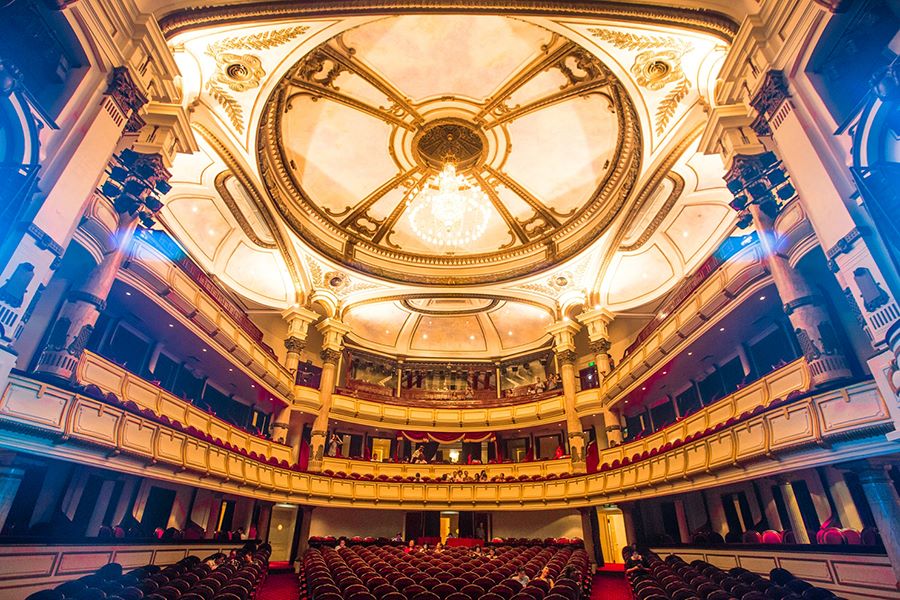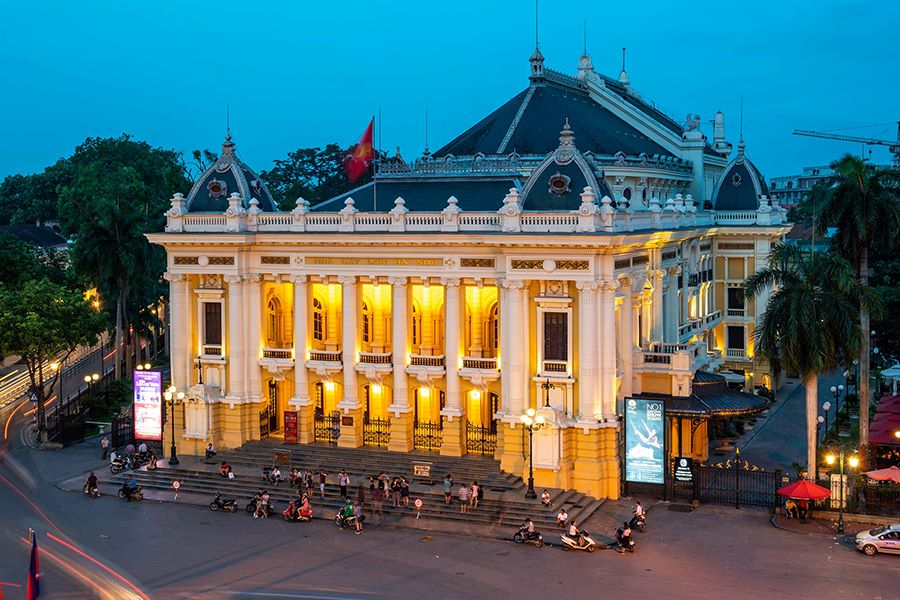Hanoi Opera House, a distinguished example of French architecture in the capital of Vietnam, has many secrets for you to explore. A Hanoi travel itinerary is one of the concerns for international tourists when they plan to visit Vietnam. Hanoi Opera House, located right in the city center, has splendid architecture and still hosts the most important events in the country. Explore its history and features to prepare for your trip to the capital city of the S-shaped country.
Contents
Where is the Hanoi Opera House?
Hanoi Opera House is situated at the Square of August Revolution, Trang Tien Street, Hoan Kiem District in downtown Hanoi. The building is proof of the exchange between Vietnamese and Western cultures and arts. It has been the venue for many important cultural shows and is also a popular attraction for visitors.
The square in front of the opera house was built in the late 19th century. It was named after the August Revolution to mark the historical milestone in 1945. There are other famed architectural works in the vicinity, such as the National Museum of Vietnamese History, Hilton Hanoi Opera, and Sofitel Legend Metropole Hanoi.
Learn about the history of the Opera House in Hanoi
After setting foot in Hanoi in 1883, the French authorities had the intention to build a center for art and culture to serve their demand for arts. Thus, construction of the Hanoi Opera House was started in 1901 and completed 10 years later. It was designed by the architects Boyer, V. Harley, and later Francois Lagisquet as a miniature of the Garnier Palace in Paris. Hence, the Opera House in Hanoi has a classical European style, bringing about the most luxurious academic art space in Indochina.
After the Opera House’s construction, the French organized many ballet shows, concerts, and pantomimes to serve the French people here as well as introduce French culture to Vietnamese people. After 1945, the Hanoi Opera House became a meeting place for the Government, and the National Assembly and hosted many drama performances. It was used as a venue for Vietnamese artists.
After the French withdrew from Hanoi in 1954, the Vietnamese government continued to preserve the Opera House. At the end of the 20th century, after 80 years, the Hanoi Opera House was in a somewhat dilapidated condition. The Vietnamese government decided to renovate it under the supervision of the French-Vietnamese architect Ho Thieu Tri.
Today, the Hanoi Opera House is one of the largest opera houses in Vietnam, which has been hosting numerous academic art shows and is also a tourist magnet in the city.
Admire the outstanding Hanoi Opera House architecture
Hanoi Opera House was built to host classical art shows such as chamber music, opera, ballet, and drama. With a total area of some 2,600 square meters, the Opera House has 3 areas including the front hall, mirror chamber, and performance hall. All areas are decorated with French-style classical chandeliers.
The front hall is used to welcome guests, with a T-shaped staircase leading to the second floor. The floor of this area is tiled with stones, while the walls and columns are decorated with luxurious classical patterns.
The mirror chamber is on the second floor, which has hosted many important ceremonies. The floor of this chamber is tiled with stones imported from Italy. Large mirrors are installed between doors and windows, and crystal chandeliers are hung.
The performance hall is finely designed with Corinthian columns painted with colorful patterns. High in the middle of the hall, there is a huge crystal chandelier. The hall can host 870 people with three floors of red velvet seats, which is typical of the French classical style of the 19th century. The performance hall is a harmonious combination of sound, light, and colors, offering a perfect art space.
Behind the stage is a room for make-up, a room for costume, a rehearsal room, and some rooms for administration and library.
The system of pillars and stone-tiled roofs follow the Roman Ionic Order. The curved balconies and dome over the main entrance depict Baroque architecture in Italian early 17th century. The roof over two sides along the entrance for cars is typical of Art Nouveau Style. All the details create a strong feeling of an Eclecticism-based Neoclassical construction.
Tips for your visit to the Hanoi Opera House
Hanoi Opera House opening hours
Hanoi Opera House’s opening hours are on Mondays and Fridays. However, it can also be open at other times, depending on the arrangement of the management board.
Each visit can last for 1.5 hours, between 10:30 a.m. and 12 p.m., which should be long enough for you to tour around and take photos.
Hanoi Opera House entrance fee
There are two tour packages at the Opera House in Hanoi:
Hanoi Opera House Tour
Max: 20 people/visit
Time: 70 minutes/visit
Ticket: VND120,000/pax (about US$4.8)
Opening days: Monday, Tuesday, Wednesday, Thursday, Saturday & Sunday
Hanoi Opera House Tour & Art Show
Max: 250 people/visit
Time: 90 minutes/visit
Ticket: VND400,000/pax
Opening days: Monday & Thursday
Besides, you can book tickets for art shows at the Opera House, at around VND300,000/pax.
Other tips to know
- In order to explore the Hanoi Opera House with ease, note down the following tips:
- Buy Hanoi Opera House tickets before entering
- Turn on your phone’s silent mode and do not use cameras during the show
- Keep silent during the show
- Do not smoke, bring snacks or chewing gum inside
- The Opera House will close 15 minutes after the show starts, so you should come early
Hanoi, the capital of Vietnam, has many mysterious things for tourists to unveil. In particular, the Hanoi Opera House, with its French architecture, is a priceless heritage of the city. Besides its function as a cultural venue of Hanoi, the opera house is also a popular destination for tourists. Take the above-mentioned top tips from Viet Dan Travel to have a flawless trip here.

